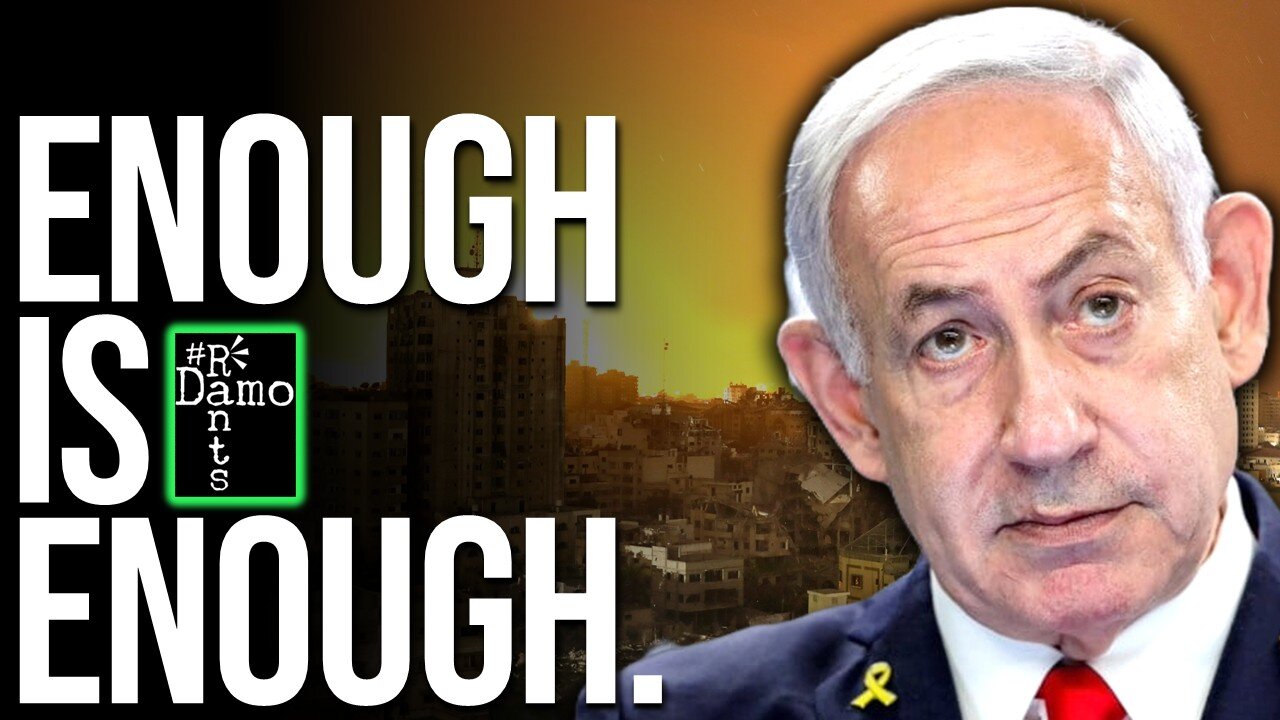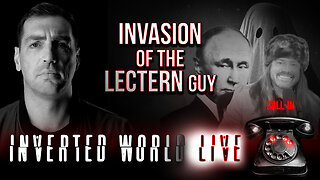Premium Only Content

Israel 'Breaks' Another Gaza Ceasefire — And the World’s Had Enough
Right, so Donald Trump had just announced “peace in our time,” complete with the usual self-congratulation and a conveniently placed Truth Social post drafted before the ceasefire even existed. Benjamin Netanyahu, meanwhile, nodded along in public while his air force keeps on razing Gaza, at least at time of writing that is, past the time the ceasefire was supposed to come into effect, but not before his cabinet meeting to ratify it from Israel’s side, claiming it hadn’t technically started yet. That’s the genius of modern diplomacy — the ceasefire that exists entirely in the press release. But will it actually come into being when for as much as the world and the people of Gaza want to see a ceasefire and an end to this genocide, Netanyahu is the Prime Minister for whom the genocide is the only thing keeping him in power,
Right, so at midday in Gaza, the genocide was meant to stop. The ceasefire was scheduled to begin at twelve o’clock Al-Quds time, the “first phase” of a plan announced the night before by Donald Trump from the White House. Instead, the hour came and went with the familiar sound of explosions. Airstrikes hit Beit Lahia and Jabalia. Smoke rose over the northern Strip while foreign broadcasters spoke of peace.
Cognitive dissonance was complete. On paper, Israel and Hamas had agreed to a phased truce — a path that, in theory, would end two years of devastation. In practice, the bombs are still falling. Israeli forces were still conducting operations as Trump’s aides congratulated themselves on ending the war.
The plan, finalised in Sharm el-Sheikh with Qatari, Egyptian, and Turkish mediation, was supposed to be simple. Israel would halt its military assault, withdraw forces from the north, reopen border crossings, allow the free entry of humanitarian aid, and begin a reciprocal prisoner exchange. Hamas would release Israeli captives and commit to halting rocket fire.
It was the most detailed agreement since the failed truce in January. But Israel immediately reframed it as a “framework,” not a binding deal — a semantic shift that has become standard whenever accountability threatens to materialise.
Trump’s announcement today was not diplomacy; it was a press event. he declared “a great day for peace in the Middle East.” But photographers captured a telling image: Senator Marco Rubio handing Trump a note reminding him to “approve a Truth Social post soon so you can announce the Gaza ceasefire deal first.” Well why would he need to do that first if all was agreed?
That note, was more than a curiosity. It encapsulated the underlying logic of the whole spectacle. The ceasefire was not about ending a war — it was about claiming ownership of its ending. Trump wanted the credit before Netanyahu could claim it, or, more likely, wreck it.
In that pursuit, he announced the deal before Israel’s cabinet had even convened and they still haven’t yet at time of writing. US officials privately admitted the ratification process was incomplete. Still, Trump told the cameras that “both sides have agreed to a path toward peace.” The phrasing was deliberately vague: a statement that could be celebrated regardless of what happened next.
The press conference was performance dressed as policy. Trump needed to appear as the statesman who achieved what others could not. Still thinking about that Nobel Prize he seems to be obsessed with right now. Netanyahu, facing a crumbling coalition at home, needed to appear cooperative without surrendering any military advantage. So both found in each other a shared incentive for illusion.
So what is emerging is not peace per se, but parallel self-preservation — two leaders exploiting the same conflict to sustain their own political narratives. It’s not a great basis to build on.
By the time Trump was declaring victory, Netanyahu’s governing coalition had already lost its majority. The ultra-Orthodox parties — Shas and United Torah Judaism — had quit the government back in July over legislation that forced Haredi men into military service. Their departure left Netanyahu without a majority, dependent on the far-right factions of Bezalel Smotrich and Itamar Ben Gvir even more, both of whom openly opposed any ceasefire.
Smotrich has immediately pledged to vote against the ceasefire, calling it “a surrender to terrorism.” Ben Gvir has already threatened to withdraw from the coalition, potentially collapsing Netanyahu into minority rule if he can even manage that, if Hamas remained intact after the hostage exchange. Their erasure is not part of the plan, they must simply cede power to a Palestinian interim administration, which they have agreed to do.
So this is the trap Netanyahu is in. Agreeing to the ceasefire would placate Washington and defuse growing international outrage over the humanitarian catastrophe in Gaza. Rejecting it would please his coalition but risk diplomatic isolation and domestic unrest. Netanyahu’s solution was the one he has used for years: appear to support the deal, but undermine its execution until it fails and the lack of ratification right now, offers him that chance.
Israel rarely rejects peace outright. It kills it through procedure. It begins with language. Officials rebrand a signed ceasefire as a “framework.” They add qualifying phrases such as “pending cabinet approval” or “subject to security review.” Each adjustment buys time, creating a legal buffer between commitment and compliance.
That is exactly what happened after Trump’s speech. Israeli media began reporting that “the ceasefire will take effect once formally ratified by the government.” And then the military resumed operations in northern Gaza as if nothing had changed, justified as “defensive measures” until the cabinet meeting could be held.
Missiles have again struck civilian areas as Israeli officials repeated that the ceasefire had “not yet begun.”
This tactic is not new. During January’s short-lived truce, Netanyahu delayed approval for forty-eight hours, claiming further consultation was needed. The military continued bombing throughout. Israel later blamed Hamas for violating the agreement when it was them. The repetition is not coincidental. It is institutional behaviour.
The most visible act of sabotage came through the prisoner exchange clause — the one element of the agreement with measurable deliverables. Mediators had finalised reciprocal lists: Hamas would release Israeli captives, Israel would release Palestinian detainees. Both sides had agreed to the names.
Within hours, Netanyahu’s office announced that Israel was “reviewing” the lists, citing unspecified “security concerns.” That decision has frozen implementation. Here we go again. Hamas accused Israel of acting in bad faith. After all this time, after all we’ve seen, would you argue that point?
Hamas official Mahmoud Merdawi said that Netanyahu was trying to destroy the ceasefire before it began, using the prisoner lists as a pretext. He argued that the move revealed Israel’s real intentions regarding troop withdrawal, reconstruction, and the reopening of crossings.
This was more than obstruction. It was a calculated political act. By contesting the lists, Netanyahu transformed a humanitarian step into a political minefield. Each delay provided justification for continued bombing while allowing him to tell the public that Israel remained “engaged in process.”
This strategy again mirrors his January approach, when three prisoners were withdrawn from the release roster on “intelligence grounds,” collapsing that truce within days. The pattern had returned: accept the deal in principle, then hollow it out clause by clause.
Hamas in contrast had issued a statement striking a far different tone. They thanked Qatar, Egypt, and Turkiye for their mediation and even “appreciated the efforts of President Trump” in reaching a deal to end the war.
The tone was calculated — legalistic rather than militant. The statement described the ceasefire as a step toward ending the “genocidal war against our Palestinian people” and ensuring “the withdrawal of the occupation from the Gaza Strip.” It called on Trump and the guarantor states to compel Israel to implement its commitments.
In follow-up remarks, Hamas accused Israel of “manipulating the schedules, lists, and agreed steps,” warning that the occupation was stalling on troop withdrawal and the return of displaced persons.
Hamas, long framed as the irrational actor, now spoke the language of international law and of course did so previously when they accepted Trump’s peace plan, with a few caveats. Israel, by contrast, is relying once more on procedural loopholes and security jargon to justify what seems like its inevitable non-compliance.
For Israel’s allies, this shift poses a serious reputational problem. If Hamas sounds more credible than its occupier, the entire Western narrative about the conflict unravels all the more, but that’s their fault. They know what Netanyahu is like as much as we increasingly do.
This is what “peace process” has come to mean in practice. Agreements serve as shields for continued violence. The language of legality covers the reality of bombardment. Western governments praise progress while civilians keep on burying the dead.
The repetition has become ritual. Israel declares compliance “in principle,” then delays execution “pending security review,” while its military maintains “operational continuity.” Each euphemism replaces responsibility with criminality.
In Washington, Trump’s team are still describing the deal as “on track,” unwilling to contradict their own announcement. Having claimed success, they could not publicly admit that the ceasefire may still collapse if Netanyahu’s cabinet say no after all this.
The mediators’ impotence reflects a long-standing structural flaw. They act as witnesses, not enforcers. Their authority ends at the signature stage. Once the agreement is signed, compliance depends entirely on Israel’s willingness — which has never extended beyond optics.
This arrangement ensures perpetual repetition: announcement, delay, collapse, denial. Each round resets the narrative without changing the outcome. The absence of enforcement mechanisms makes failure a feature, not a flaw.
For Netanyahu, it is a political necessity that the ceasefire fail. His coalition depends on conflict. The far right’s influence is maintained through permanent crisis, and his leadership depends on portraying himself as the indispensable defender of a nation under threat.
Every truce risks splitting his base. Every escalation keeps him in power. This is the political arithmetic of modern Israel: war consolidates power, peace disperses it.
The collapse of the Haredi alliance made Netanyahu’s dependency on the settler right absolute. Figures like Smotrich and Ben Gvir define loyalty through confrontation. A sustained ceasefire would expose their irrelevance and Likud’s weakness.
For that reason, the government’s survival strategy has become indistinguishable from perpetual conflict management. What foreign mediators call “phases of peace,” Netanyahu’s cabinet treats as intervals for repositioning troops. The idea of permanent calm would destabilise the entire political system built on fear and militarism.
Trump’s role in this performance is equally revealing. For days before the announcement, he teased the deal on social media, hinting he might “travel to the Middle East to sign it personally.” His aides pushed to time the announcement for maximum media impact.
In this sense, Trump and Netanyahu share a political language — one in which appearance outweighs reality. Both rely on the spectacle of success rather than its substance.
Inside Gaza, the gap between announcement and reality was deadly. Believing the ceasefire had begun, civilians emerged to find supplies and check on relatives. Several were killed in renewed airstrikes within the first hours. Hospitals already operating at capacity struggled to cope with the new influx of casualties.
The lived experience of Gazans has become a grim routine: each new ceasefire brings hope, followed by betrayal. Every announcement raises expectations that collapse under renewed bombardment. It is a pattern not of miscommunication but of policy — a deliberate manipulation of expectation as a weapon of control.
The rhetoric surrounding the deal exposes a deeper moral reversal. Hamas, often condemned as lawless, grounded its statements in the language of international humanitarian law. Israel, long claiming to uphold such norms, relied on loopholes and procedural deferrals to wriggle out of it.
The Hamas communiqué described the ceasefire as “the beginning of ending the genocide,” directly referencing the International Court of Justice proceedings. This was a strategic legal framing. Each Israeli delay could now be interpreted as continued non-compliance with the ICJ’s provisional measures.
Israel’s official discourse, by contrast, reduced everything to security procedure: “legal verification,” “conditional approval,” “security consultation.” Each phrase transformed an act of obstruction into an appearance of caution. The weaponisation of legality has become an essential part of Israel’s diplomatic playbook.
The result is an inversion of legitimacy. The actor portrayed as terrorist appears more faithful to international norms than the state claiming democratic virtue. That inversion, visible to audiences across the world, is eroding the moral foundation of Western support for Israel.
Every repetition of this pattern — agreement, breach, denial — erodes the credibility of international mediation. The mediators issue statements of concern, Western leaders urge restraint, and Israel resumes operations. The language of diplomacy conceals the reality of failure.
The inability to enforce compliance exposes the systemic imbalance at the heart of the so-called peace process. The United States cannot be a neutral guarantor while supplying Israel with weapons and diplomatic protection. Egypt, reliant on US aid and constrained by border agreements, has little capacity to confront its neighbour. Qatar and Turkiye act in good faith but lack coercive power.
The result is a structure that institutionalises impunity. Agreements are made in the expectation that they can be broken without consequence. Each truce becomes another layer in the architecture of occupation.
Until a framework exists that includes enforceable penalties for violations, the repetition will continue. Every “phase” of peace will end where it began — under fire.
When a ceasefire begins with more bombs, the word itself collapses. It no longer signifies restraint or resolution. It signifies public relations.
This is not merely political failure but moral degradation. The repeated performance of good faith by governments that have none corrodes the very language of peace. Each broken truce teaches the same lesson: that law without enforcement is theatre, and that promises made to Palestinians are written for Western consumption, not for the people under siege.
The international order built on Western credibility is cracking because of the very consistency of Israel’s deceit. The world now recognises the pattern. Each “truce” is announced, broken, and rationalised in real time. Each mediator repeats the same platitudes while Gaza burns. The illusion no longer convinces anyone outside the narrow circle of those invested in sustaining it.
And in that exposure lies the real reversal of this story. The actor branded illegitimate has been the only one to fulfil its commitments. The state that calls itself democratic has treated law as a tactic and peace as a threat.
In the end, the only side that kept its word was the one the world still calls unlawful.
I’d love to be proven wrong, but fundamentally without the removal of Benjamin Netanyahu from power, I cannot foresee an actual end to this genocide, it would literally put him out of power and nothing is worth a price that high to him. Perhaps a short break for optic sake as we saw in January, but nothing more.
And in a further demonstration of how much Netanyahu truly isn’t in charge here now, how about his far right coalition ministers getting together to pass a death penalty policy whilst parliament was in recess? Only for Palestinians of course. Get all the details of that story in this video recommendation here as your suggested next watch.
Please do also hit like, share and subscribe if you haven’t done so already so as to ensure you don’t miss out on all new daily content as well as spreading the word and helping to support the channel at the same time which is very much appreciated, holding power to account for ordinary working class people and I will hopefully catch you on the next vid. Cheers folks.
-
 15:09
15:09
GritsGG
14 hours agoSolo Warzone Victory! Shadow Banned!
11.3K -
 LIVE
LIVE
Lofi Girl
3 years agolofi hip hop radio 📚 - beats to relax/study to
225 watching -
 12:19
12:19
BlabberingCollector
1 day agoPotter Fans In Frenzy, Keira Knightly Responds To Potter Involvement Backlash | Wizarding World News
11K -
 2:56:20
2:56:20
FreshandFit
13 hours agoThe Price Is Right! Fresh&Fit After Hours Edition
198K73 -
 6:45
6:45
The Power of Connection
2 days agoThe Power of Connection : Networking vs. Connecting
13K4 -
 28:53
28:53
Afshin Rattansi's Going Underground
3 days agoTrump Has Surrounded Himself With Neocons AGAIN, War After War is Coming! (James Carden)
21.1K20 -
 1:54:50
1:54:50
Badlands Media
12 hours agoDevolution Power Hour Ep. 398: Economic Warfare, Trump’s Strategy, and the Coming Reckoning
77.9K31 -
 2:08:19
2:08:19
Inverted World Live
10 hours agoInvasion of the Lectern Guy | Ep. 124
55.6K6 -
 2:54:29
2:54:29
TimcastIRL
10 hours agoDemocrats Declare STATE OF EMERGENCY Over ICE Raids, DHS ATTACKED, CIVIL WAR | Timcast IRL
254K151 -
 2:37:25
2:37:25
TheSaltyCracker
10 hours agoAlex Jones Gets Screwed ReeEEStream 10-15-25
112K272